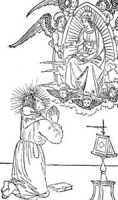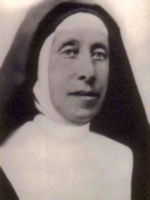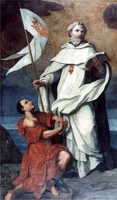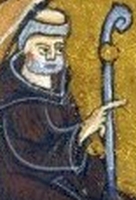| 25 December |
• yesterday • tomorrow |
| Solemnity of the Nativity of the Lord |

• Feast of the Nativity
• Nativity of the Lord
Cristes Maesse, Christ's Mass (Old English)
Celebration of the anniversary of the birth of Our Lord. In the earliest days of the Church there was no such feast; the Saviour's birth was commemorated with the Epiphany by the Greek and other Eastern Churches. First mention of the feast, then kept on 20 May, was made by Clement of Alexandria c.200. The Latin Church began c.300 to observe it on 25 December, though there is no certainty that Our Lord was born on that day. Priests have the privilege of saying three Masses, at midnight, daybreak, and morning. This was originally reserved to the pope alone; beginning about the 4th century he celebrated a midnight Mass in the Lateran Basilica (in which according to tradition, the manger of Bethlehem is preserved), a second in the church of Saint Anastasia, whose feast comes on 25 December, and a third at the Vatican Basilica. Many peculiar customs of the day are the outcome of the pagan celebrations of the January calends. The Christmas tree, of which the first known mention was made in 1605 at Strasbourg, was introduced into France and England in 1840. The feast is a holy day of obligation, preceded by the preparatory season of Advent and by a special vigil; should it fall on a Friday it abrogates the law of abstinence.
https://catholicsaints.info/christmas/

• Crazy Jim
• Iacopone da Todi
• Jacomo da Todi
• Jacopo Benedetti
• Jacopo Benedicti
• Jacopone Benedetti da Todi
• Jacopone of Todi
• James da Todi
Italian noble from the Benedetti family of Todi. Successful lawyer at Bologna, Italy. Married to Vanna di Guidone in 1267; she considered Jacomo too worldly, and did penance for him. In 1268, Jacomo insisted she attend a public tournament against her wishes; the stands in which she sat collapsed, and Vanna was killed. The shock of this event, and his discovery of her penance for him, caused a radical change in Jacomo. He gave his possessions to the poor, dressed in rags, and became a Franciscan tertiary. His former associates called him Jacopone - Crazy Jim; he embraced the name.
After ten years of this penance and abuse, Jacomo tried to join the Franciscans; his reputation as Crazy Jim preceeded him, and he was refused. To prove his sanity and intentions, he wrote a beautiful poem about the vanities of the world; it swayed the Franciscans, and he joined the Order in 1278. He refused to be ordained, and spent time writing popular hymns in the vernacular.
Jacopone suddenly found himself a leader in a disturbing religious movement among the Franciscans. The Spirituals, as they were called, wanted a return to the strict poverty of Francis. They had the support of two cardinals and Pope Celestine V. The two cardinals, however, opposed Celestine's successor, Boniface VIII, and due to the wrangling in the Vatican, Jacopone was excommunicated and imprisoned at age 68. Jacopone acknowledged his error, but was not released until Blessed Benedict XI became pope five years later. Jacopone accepted his imprisonment as penance. He spent his last three years giving himself to completely to spirituality, weeping "because Love is not loved," and writing, including the famous Latin hymn, Stabat Mater.
c.1230 at Todi, Italy as Jacopo Benedetti
• 25 December 1306 at Collazzone, Italy of natural causes as a priest intoned the Gloria from midnight Mass
• relics at San Fortunato Church, Montecristo, Italy
• Franciscan tertiary kneeling before a vision of the Virgin surrounded by angels
• barefoot Franciscan holding a book
Here lie the bones of Blessed Jacopone dei Benedetti da Todi, Friar Minor, who, having gone mad with love of Christ, by a new artifice deceived the world and took Heaven by violence. - from the tomb of Blessed Jacopone
The Stabat Mater
At the cross her station keeping,
Stood the mournful Mother weeping,
Close to Jesus to the last.
Through her heart, His sorrow sharing,
All His bitter anguish bearing,
Now at length the sword had pass'd.
Oh, how sad and sore distress'd
Was that Mother highly blest
Of the sole-begotten One!
Christ above in torment hangs;
She beneath beholds the pangs
Of her dying glorious Son.
Is there one who would not weep,
Whelm'd in miseries so deep
Christ's dear Mother to behold?
Can the human heart refrain
From partaking in her pain,
In that Mother's pain untold?
Bruis'd, derided, curs'd, defil'd,
She beheld her tender child
All with bloody scourges rent.
For the sins of His own nation,
Saw Him hang in desolation,
Till His spirit forth He sent.
O thou Mother! fount of love!
Touch my spirit from above;
Make my heart with thine accord.
Make me feel as thou hast felt;
Make my soul to glow and melt
With the love of Christ our Lord.
Holy Mother! pierce me through;
In my heart each wound renew
Of my Saviour crucified.
Let me share with thee His pain,
Who for all my sins was slain,
Who for me in torments died.
Let me mingle tears with thee,
Mourning Him who mourn'd for me,
All the days that I may live.
By the cross with thee to stay,
There with thee to weep and pray,
Is all I ask of thee to give.
Virgin of all virgins best,
Listen to my fond request
Let me share thy grief divine.
Let me, to my latest breath,
In my body bear the death
Of that dying Son of thine.
Wounded with His every wound,
Steep my soul till it hath swoon'd
In His very blood away.
Be to me, O Virgin, nigh,
Lest in flames I burn and die,
In His awful Judgment day.
Christ, when Thou shalt call me hence,
Be Thy Mother my defense,
Be Thy cross my victory.
While my body here decays,
May my soul Thy goodness praise,
Safe in Paradise with Thee.
Amen.
- Blessed Jacopone da Todi
https://catholicsaints.info/blessed-jacopone-da-todi/>

• Maria of the Apostles
• Mary of the Apostles
Born to the German nobility, the eldest of five daughters of Baron Theodor von Wüllenweber. Always deeply religious, as a girl Maria-Therese felt drawn to religious life, and wanted to become a missionary. Educated by tutors and the Benedictines of Liege, Belgium. At age 24 she entered the convent of the Sacred Heart, Blumenthal, Germany. Held positions of authority in convents in Warendort, Germany and Orleans, France. Coming to understand that her vocation was not as a teacher, she left religious life in March 1863, and returned home to her family. She developed a devotion to the Sacred Heart, and was briefly involved with the Sisters of the Visitation, but it wasn't until 1868 that she became a member of the Congregation of Perpetual Adoration in Brussels, Belgium and began working with the poor. She began leading such work in Germany, but it was duing the anti-Catholic kulturkampf era, and in 1870 she returned to her family home. Co-founded the Sisters of the Divine Savior (Salvatorian Sisters) on 8 December 1888, and served as their first superior. The Sisters continue their good work today in 27 countries.
19 February 1833 in Myllendonk Castle, Mönchengladbach, Düsseldorf, Germany
• 25 December 1907 in Rome, Italy of natural causes
• relics enshrined in the General House of the Suore Salvatoriane, Via Mura Gianicolensi, Rome
13 October 1968 by Pope Paul VI
https://catholicsaints.info/blessed-maria-therese-von-wullenweber/

Pedro
6 May (Mercedarians)
Born to the French nobility. Grew up a pious youth. His father died when Peter was fifteen, and he inherited a substantial fortune. When he came of age, he gave away his possessions and moved to Barcelona, Spain to avoid the Albigensian heretics. He later took part in the Crusades against the Albigensians in southern France. Tutor to King James I of Aragon. Settled in Barcelona. Friend of Saint Raymond Penyafort. He used his large inheritance to ransom Christians held prisoner by the Moors. Founded the Order of Our Lady of Mercy (Mercedarians) beginning in 1218, an order devoted to ransoming Christians; the Order received papal approval in 1230. Peter twice served as a captive in Africa, winning the release of over 400 captives. In 1249, Peter retired from the Order to spend his remaining days in quiet prayer.
1182 at Mas-des-Saintes-Puelles, near Castelnaudary, Languedoc, France
25 December 1258 of natural causes
30 September 1628 by Pope Urban VIII (cultus confirmation)
https://catholicsaints.info/saint-peter-nolasco/

• Peter of Cluny
• Peter of Montboissier
• 29 April as one of the Abbots of Cluny
• 11 May (Benedictines)
Born to the French nobility. Benedictine monk at Cluny Abbey, and at several sister houses. Abbot of Cluny in 1122. Instituted a number of reforms to the educational and financial areas of the houses; his emphasis on the education of his monks put him into some conflict with Saint Bernard of Clairvaux who felt it detracted from the emphasis on prayer. Peter travelled to England, Spain and Rome, Italy in service to the Order, retiring between trips to live as a hermit. He recommended that the Koran be translated to Latin so missionaries would better understand what they were up against when they evangelized Muslims. Wrote poems, sermons, scriptural studies and treatises against heresy.
1092 in Auvergne, France
• 25 December 1156 of natural causes
• buried in the southern end of the cloister of the monastery church of Cluny Abbey
• grave desecrated by Huguenots in 1562
• grave and most relics destroyed in 1792 in the anti-Christian excesses of the French Revolution
• some relics re-discovered in 1931 where they had been hidden in a stable
1862 by Pope Pius IX (cultus confirmation)
https://catholicsaints.info/blessed-peter-the-venerable/

Daughter of Saint Fausta of Sirmium. Matron of a noble Roman family. Married to a pagan. Spiritual student of Saint Chrysogonus. Martyred in the persecutions of Diocletian.
Her name is commemorated in the second Mass of Christmas and the first eucharistic prayer. Nothing is really known about her except her death, but there have been no end of attempts by story-tellers to fill in the blanks.
• burned to death c.304 at Sirmium, Dalmatia
• relics at Istanbul, Turkey (former Constantinople)
• martyrs
• weavers
• widows
• woman with palm branch of martyrdom
• woman holding a small cross and vase
• woman with a flame in her hand
• woman holding a bowl with a flame in it
https://catholicsaints.info/saint-anastasia-of-sirmium/

• Bentivolius Bonis
• Bentivoglio de Bonis of San Severino Marche
One of Saint Francis of Assisi's earliest disciples and one of first Franciscans. Priest. Noted preachers, miracle worker, healer and visionary.
1188 at San Severino, Italy
25 December 1232 at San Severino, Italy of natural causes
30 December 1852 by Pope Blessed Pius IX (cultus confirmed)
https://catholicsaints.info/blessed-bentivoglio-de-bonis/

• Folquet
• the Minstrel Bishop
Professional minstrel. Benedictine Cistercian monk at Thoronet, France. Abbot in 1200. Bishop of Toulouse, France in 1206. Helped Saint Dominic de Guzman found the Order of Preachers by providing him a base of operations, books, equipment, and one-sixth of the church tithes.
c.1155 at Genoa, Italy
1231 of natural causes
https://catholicsaints.info/blessed-fulk-of-toulouse/
Princess, the half-sister of King Egbert of Wessex. Wife of Earl Wulstan of Wiltshire who founded Wilton Abbey near Salisbury, England in 773. Widowed in 800. She converted Wilton Abbey into a convent for women, retired there with a dozen fellow Benedictine nuns, and is also considered a founder of the house.
in Wessex, England
810 at Wilton abbey, England of natural causes
https://catholicsaints.info/saint-alburga-of-wilton/

Young noble woman. Converted by and martyred with her servants, Saint Hyacinth and Saint Protus during the persecution Valerian. Her Acta read like a melodramatic adventure novel, but are worthless as biography.
• c.258, probably by beheading
• buried in Apronianus cemetery on the Via Latina
https://catholicsaints.info/saint-eugenia-of-rome/
Adalasenda, Adalsendis, Adalsind
Daughter of Saint Adalbald of Ostrevant and Saint Rictrudis of Marchiennes. Sister of Saint Eusebia of Hamay, Saint Clotsind and Saint Mauront. Benedictine nun at Hamay-les-Marchiennes near Arras, France and spiritual student of her sister.
c.715 of natural causes
https://catholicsaints.info/saint-adalsindis-of-hamay/
Jesuit. Martyred for hiding and assisting priests and missionaries.
c.1583 in Machiai, Kumamoto, Japan
scalded to death in the hot springs at Mount Ungen, Shimabara, Japan on 25 December 1628
7 May 1867 by Pope Pius IX
https://catholicsaints.info/blessed-michael-nakashima-saburoemon/
Canon of Rheims, France. Benedictine Cluniac monk at Saint-Martin-des-Champs in 1108. Prior of his house in 1117. Created cardinal bishop of Albano in 1125. Papal legate in France and Germany in 1128. Staunch supported of the Cluniac ideal. Close friend of Blessed Peter the Venerable.
1134 of natural causes
https://catholicsaints.info/blessed-matthew-of-albano/

Mercedarian friar at the convent of Santa Maria Guardia in Prats, Spain (in modern Andorra). Helped ransom a total of 132 Christians enslaved by Moors in Granada, Spain.
https://catholicsaints.info/blessed-diego-de-aro/

Soldier. Knight. Lay member of the Mercedarians. Ransomed at least 150 Christian prisoners from slavery in Africa. Known for his personal piety.
Oran, Algeria of natural causes
https://catholicsaints.info/blessed-artale/
Basilée, Basiléo
Martyred in the persecutions of Valerian and Gallienus.
c.258 on the Vita Latina, Rome, Italy
https://catholicsaints.info/saint-basilea-of-the-via-latina/
Giovino, Iovino
Martyred in the persecutions of Valerian and Gallienus.
c.258 on the Vita Latina, Rome, Italy
https://catholicsaints.info/saint-jovin-of-the-via-latina/
Priest. Founded a monastery in Berry, France.
c.700 of natural causes
https://catholicsaints.info/saint-romulus-of-berry/
Dominican tertiary. Cared for the sick in Siena, Italy.
1230
1287 of natural causes
https://catholicsaints.info/blessed-nera/
20,000 Christians martyred by order of Diocletian. They were reported to have all been in the single basilica to celebrate Christmas. While there unquestionably was an endless series of martyrs under Diocletian, it's likely the ancient sources exaggerated the numbers of this incident. And as the Christmas holy day was not celebrated in the East in 303, they were probably gathered for another feast.
burned alive in 303 in the basilica of Nicomedia
https://catholicsaints.info/martyrs-of-nicomedia-25-december/
• Matthew Paul
• Susanna of Armenia
CatholicSaints.Info Portable Edition